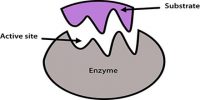- Temperature reaching the enzyme and substrate molecules causes them to raise random movement.
- The larger temperature the extra the molecules move and so the more repeatedly they collide.
- The extra collisions there are the greater the possibility that substrates will fit into an active site, up to an exact temperature.
- At the best temperature of an enzyme, the reaction rate is maximum.
- Temperature also affects the figure of the active site, the active site being the correct shape at the best temperature.
- At temperatures over optimum, the rate of reaction decreases because the active site begins to warp.
- At higher temperature causes the enzyme turn into denatured, i.e. bonding becomes irreversibly changed and the active site is permanently smashed.
- At very high temperatures, the number of collisions is also high, but without active sites, no products can be formed.
- At lower temperatures than the optimum, the rate of the reaction decreases because of reduced enzyme substrate collisions.
Most enzymes have the best temperature of between 30oC and 40oC, but there are lots of exceptions. An example of this is shown by various bacteria that live at high temperatures in hot volcanic springs.













